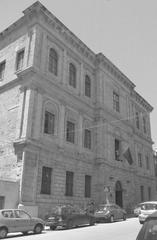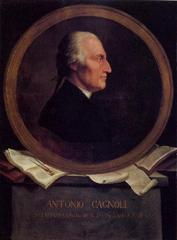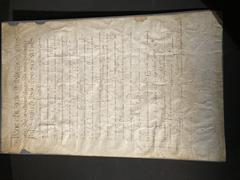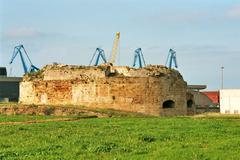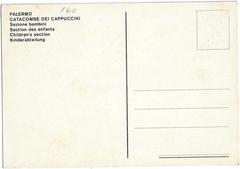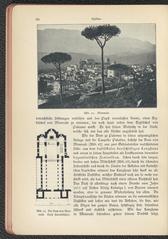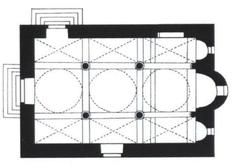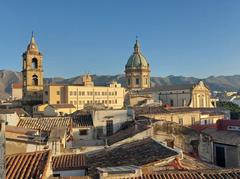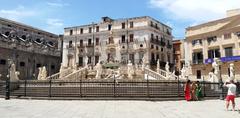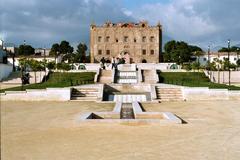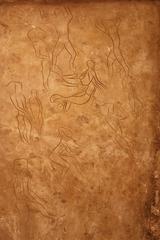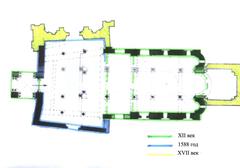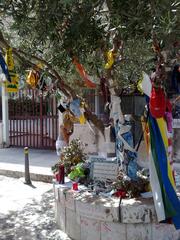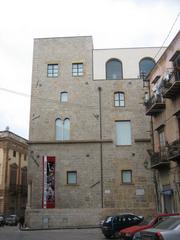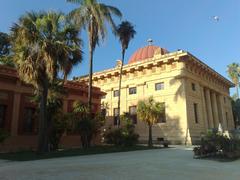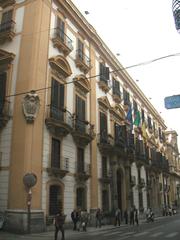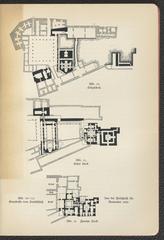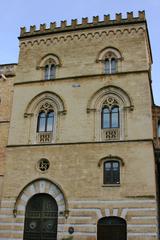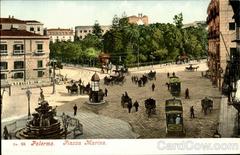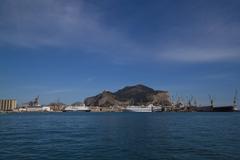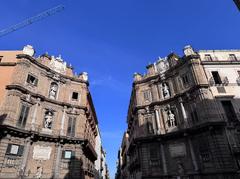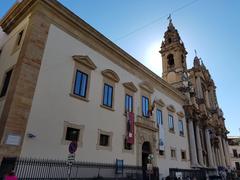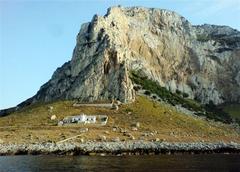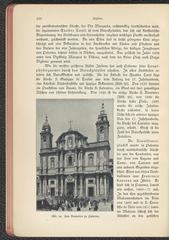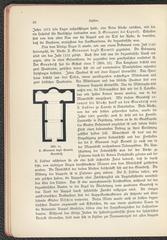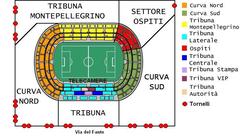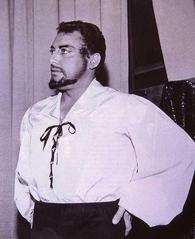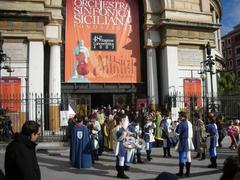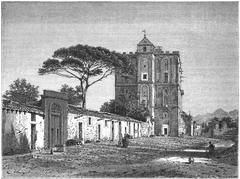Palazzina Cinese Visiting Hours, Tickets, and Historical Sites in Palermo
Date: 04/07/2025
Introduction to Palazzina Cinese and Its Significance in Palermo
Nestled in the lush Parco della Favorita, Palermo, the Palazzina Cinese (Chinese Pavilion) is a striking architectural gem that embodies the European aristocracy’s fascination with the Far East at the turn of the 19th century. Commissioned in 1799 by King Ferdinand III of Sicily, this palace is a rare and whimsical example of chinoiserie architecture, seamlessly blending Chinese motifs with neoclassical and Rococo elements. Designed by Sicilian architect Giuseppe Venanzio Marvuglia, the Palazzina Cinese served as both a royal retreat and a symbol of cultural cosmopolitanism, captivating visitors with its pagoda terraces, intricate interiors, and enchanting gardens.
This comprehensive guide details the Palazzina Cinese’s royal origins, architectural highlights, gardens, visiting information, and practical travel tips. Whether you’re an architecture enthusiast, history buff, or curious explorer, this resource will help you plan an engaging visit to one of Palermo’s most unique historical sites. For official and up-to-date visitor details, consult sources like Slow Sicily, Atlas Obscura, and the Comune di Palermo tourism site.
Contents
- Introduction
- Royal Origins and Commissioning
- Architectural Evolution and Features
- The Gardens and Surrounding Estate
- Political Transition and Restoration
- Visiting Hours, Tickets, and Visitor Information
- Travel Tips and Nearby Attractions
- Cultural Significance
- FAQ
- Conclusion and Call to Action
- References
Royal Origins and Commissioning
The Palazzina Cinese, also called the Chinese Palace or Real Casina alla Cinese, was commissioned in 1799 by King Ferdinand III of Sicily after he sought refuge in Palermo during the Napoleonic Wars. The king acquired an already partially Chinese-inspired villa from Baron Benedetto Lombardo (Wikipedia; Slow Sicily). Inspired by the prevailing European chinoiserie trend, Ferdinand III engaged Giuseppe Venanzio Marvuglia to expand and transform the villa into a dazzling royal residence between 1800 and 1806. The result is a fusion of Chinese, neoclassical, and Rococo styles, making the Palazzina Cinese one of Sicily’s most imaginative and prestigious buildings (Atlas Obscura; Italian Traditions).
Architectural Evolution and Features
The Palazzina Cinese is a vivid example of late 18th-century chinoiserie, interpreted through a European lens. The palace comprises three main floors above a semi-underground ballroom, all crowned by a distinctive octagonal, pagoda-style terrace. The exterior features a masonry façade with wooden balconies, painted railings, and whimsical pavilion roofs adorned with carved beams and Chinese-themed decorations (Italian Traditions; Comune di Palermo).
Inside, the palace is organized into five levels:
- Basement: Contains the grand ballroom, hallways, King Ferdinand’s bathroom, the “Sala delle Codine” buffet room, and the celebrated “mathematical table”—a mechanical dumbwaiter system for discreet serving (Atlas Obscura).
- Mezzanine: Home to the main reception hall (“Sala delle Udienze”) and the king’s private chambers.
- First Floor: Reserved for knights, dames, and service staff.
- Second Floor: Contains the queen’s apartments, including the “Turkish living room,” “Herculaneum room,” and the queen’s bedroom with a “cabinet of stones” bathroom.
- Top Floor: The “Room of the Winds,” originally intended as an observatory (Italian Traditions).
Lavish frescoes, trompe l’oeil effects, and a blend of Chinese, Turkish, Pompeian, and neoclassical decor adorn the interiors. Noted artists such as Giuseppe Velasco, Elia Interguglielmi, and Vincenzo Riolo contributed to the vibrant pictorial program (Lonely Planet; Italian Traditions).
The Gardens and Surrounding Estate
Set within Parco della Favorita, the Palazzina Cinese is surrounded by gardens that mirror its exotic themes. The park features ancient trees, winding paths, dragon-adorned fountains, and a formal Italian garden with labyrinthine hedges and centuries-old trees (Slow Sicily; Sicile Sicilia). The spiral staircases, pagoda-style rooflines, and fountains add to the estate’s enchanting character.
Political Transition and Restoration
After serving as a royal residence until the Unification of Italy in 1860, the Palazzina Cinese passed to the House of Savoy and then the city of Palermo (Wikipedia). The palace endured periods of neglect before major restoration efforts—including a significant campaign in 2013—revived its architectural and artistic splendor (Slow Sicily). Today, it houses the Ethnographic Museum of Sicily, named after Giuseppe Pitrè, which displays Sicilian folk art and traditions (Atlas Obscura; Sicile Sicilia).
Visiting Hours, Tickets, and Visitor Information
- Opening Hours: Generally Tuesday to Sunday, 9:00 AM–6:00 PM (last entry 5:30 PM). Closed Mondays and on select holidays. Hours may vary—check the official website before visiting.
- Tickets: Standard adult tickets are €8, reduced rates (students, seniors) €5, and free entry for children under 6 and certain other categories. Admission may sometimes be free for all visitors (palermo.esn.it).
- Booking: Purchase tickets online or at the entrance. Guided tours (offered in Italian and on request in English/other languages) may require advance booking.
- Accessibility: The ground floor and some exhibition areas are accessible via ramps; upper floors require stair access.
Travel Tips and Nearby Attractions
- Location: Viale Duca degli Abruzzi, 1, within Parco della Favorita. Reachable by car, taxi, or public transport (bus lines 107, 615, 645).
- Nearby Sites: Combine your visit with Monte Pellegrino (including the Sanctuary of Santa Rosalia), the Palermo Zoo, and the Mondello seafront.
- Best Times: Weekdays and mornings are less crowded.
- What to Bring: Comfortable shoes, sun/rain protection, water.
- Photography: Allowed without flash or tripods; food and drink are not permitted inside.
- Duration: A typical visit lasts 60–90 minutes.
Cultural Significance
The Palazzina Cinese is more than a royal folly—it’s a testament to Palermo’s centuries-old openness to cultural exchange. Its chinoiserie style is unique in Sicily, underscoring the island’s position as a crossroads of civilizations. The palace’s restoration and current role as a museum celebrate both exotic influences and Sicilian folk traditions (Lonely Planet; Slow Sicily).
Frequently Asked Questions (FAQ)
Q: What are the Palazzina Cinese opening hours?
A: Generally Tuesday–Sunday, 9:00 AM–6:00 PM; closed Mondays. Check for holiday variations.
Q: How can I buy tickets?
A: Online via the official website or at the entrance.
Q: Is the site wheelchair accessible?
A: Partially—ground floor and some exhibition spaces are accessible; upper floors require stairs.
Q: Are guided tours available?
A: Yes, in Italian and sometimes in English/other languages; advance booking recommended.
Q: Are there nearby attractions?
A: Yes—Monte Pellegrino, Palermo Zoo, and the extensive Parco della Favorita.
Conclusion and Call to Action
The Palazzina Cinese offers a journey through Palermo’s royal and multicultural heritage, standing as a rare fusion of Sicilian craftsmanship and exotic inspiration. With its restored interiors, innovative features like the mechanical dumbwaiter, and tranquil gardens, it’s a must-see for any visitor. For the best experience, check current hours, book tours in advance, and explore the surrounding park. For travel tips and the latest updates, download the Audiala app and follow our social channels.
References
- Palazzina Cinese Palermo: Visiting Hours, Tickets, and Historical Insights, 2025, Slow Sicily (Slow Sicily)
- Palazzina Cinese, 2025, Atlas Obscura (Atlas Obscura)
- Palazzina Cinese Official Tourism Site, 2025, Comune di Palermo (Comune di Palermo)
- Palazzina Cinese Visiting Hours, Tickets, and Architectural Highlights in Palermo, 2025, Shaopeng Blog (Shaopeng Blog)
- Palazzina Cinese Visiting Hours, Tickets, and Guide to Palermo’s Historical Site, 2025, Palermo Today (Palermo Today)
- Palazzina Cinese Visiting Hours, Tickets & Guide to Palermo’s Historical Sites, 2025, palermo.esn.it (palermo.esn.it)
- Palazzina Cinese Visiting Hours, Tickets, and Architectural Highlights in Palermo, 2025, Turisti per Caso (Turisti per Caso)
- Palazzina Cinese and Cultural Significance, 2025, italian-traditions.com (Italian Traditions)
- Palazzina Cinese Visiting Hours, Tickets, and Guide to Palermo’s Historical Site, 2025, Sicily Guide Tourism (Sicily Guide Tourism)
- Palazzina Cinese in Historical and Cultural Context, 2025, italiani.it (italiani.it)
- Palazzina Cinese Visiting Hours, Tickets, and Guide to Palermo’s Historical Site, 2025, Trip.com (Trip.com)
